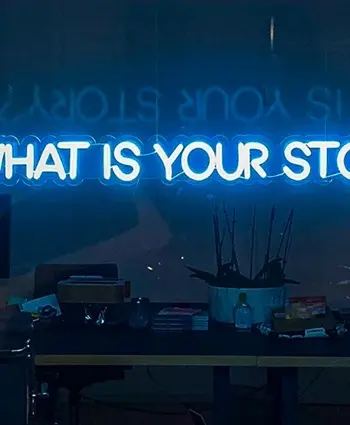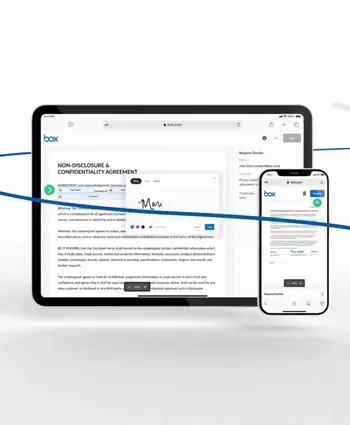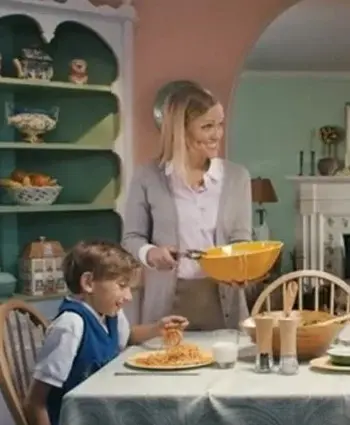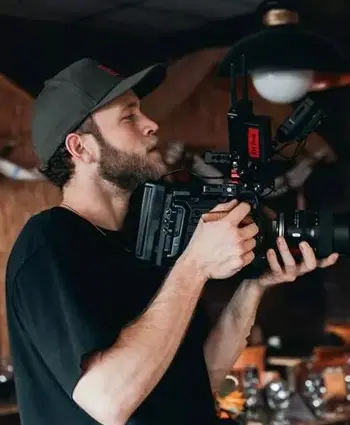
6 Super-Actionable Steps to Telling your Brand Story With Video
Discover how to tell your brand story through video with 6 actionable steps and plenty of inspiration.
There's a preconception in marketing, especially B2B marketing, that stories are fluffy, non-essential, and not real marketing.
But here's the thing about stories. They aren't fluffy. In fact, they cut through the fluff. They're the ultimate fluff-busters. They're the first thing we're drawn to in marketing, or anywhere. We're creatures predisposed to tell stories in order to make sense of a chaotic world and bring meaning to our lives. They help us empathise, and build trust. And that's exactly why stories are the most effective way to communicate your brand.
Add video, the medium best at generating emotion, and you get a potent combination ideal for spreading your brand message. A story told through visual and aural means is one of the most engaging things know to mankind (which is why we spend £30 billion each year globally on going to the movies).
Just as films enrapture people all around the world, so too can promotional video enrapture your audience and make them more receptive to your brand.
So how do you do it? This post will guide you through the process of telling your brand story through video, with 6 actionable steps, plus examples to inspire you along the way.
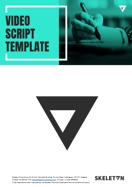 Download our Video Script Template
Download our Video Script Template
Write an effective script for your latest video project from scratch.
Our simple template provides the layout you need to create and arrange your video script, plus an example to help you along.
What Makes an Effective Brand Story?
First, let's tackle the question of what a great brand story looks like. In order to engage your audience and make them remember your brand, an effective brand story should be:
- Problem-based
To connect with your audience you always need to relate back to them and the things they care about. The best brand stories are driven by the desire to solve a specific problem your target audience are struggling with.
- Unique
A brand story is no good if it's indistinguishable from the competition. Your story needs to uniquely represent your brand to allow you to stand out in viewers' minds, whether that's through a different angle, storytelling technique, or type of video.
- Emotional
We know that emotions drive many of our purchasing decisions (yes, even in the B2B world). They also form connections and build trust. Your brand story should have an emotional crux that encourages your audience to build positive associations with you.
- Honest
Today's world is hyper-aware. If you try to be something you're not, your audience will find out sooner rather than later. So embrace honesty: show your brand as it really is and play to your real, rather than imagined, strengths.
6 Steps You Can Take Right Now to Tell Your Brand Story With Video
1. Get to the Core of Your Purpose
As Simon Sinek says, always start with your 'why'. Why do you do what you do? What's the passion that drives your brand? Which values do you believe in above all others?
And before you start thinking your 'why' is totally unrelated and irrelevant to your audience, it's not. Your 'why' should be powered by the desire to fix a problem, to do some good, to help your customers in some way. Your 'why' is the common ground you share with your audience, you just need to dig it out.
If you're lucky, your brand will already have done work into the values (openness, innovation, loyalty, ambition, passion, etc.) you share with your audience. If not, get stuck into the task below.
Your task: Gather as many colleagues as you can into a room. Ask everyone to write down, on a scrap of paper or their phone, what your brand means to them. If they need more help, try asking one or more of the following questions:
- If our brand was a person, how would you describe them?
- Which values would you say are most important to us above all else?
- What does our business believe in that stands us out from our competitors?
Then ask everyone to read out their words in turn, and explain them if they need to. Make a note of any common themes or recurring answers. This should be an open, collaborative process, so feel free to build on the responses of others (as long as everyone has a chance to talk).
You should try to leave the session with a list of about 5 values that explain why your brand exists, what it seeks to do, and what motivates all of you.
Here's a great example of a brand that gets across why they do what they do. In this 60-second video Slack, the workplace messaging app, get across their values of collaboration, empathy, and playfulness. It's clear what they're passionate about helping their clients do and become.
2. Find Visuals & Sound that Reflect Your Brand
When working with video, it's important to use everything at your disposal to tell your brand story: colours, editing, music, voiceover, and much more.
A great way to make sure you're translating your brand accurately to video is to find visuals and sound that reflect your brand before you actually begin production. If you've already created brand video guidelines, you may be able to skip this step, if not, carry on.
Your task: Put together a collection (or moodboard if you prefer) of visual and audio sources that remind you of your brand. This can include:
- Colours
- Locations
- Music
- Voices
And anything that you want!
Your aim is to conjure up the values you've identified in step 1 through a medium other than words. The visuals and music you select should represent the emotions you're trying to express, as a helpful foundation for working out how to tell your brand story.
If you're struggling to get started, take a look at this wonderful example from Tous: they make quirky jewelry full of personality and meaning. Just watch how a number of clever filmmaking choices build to express their brand. Their values of tenderness and a youthful spirit are expressed through a thoughtful story and a fast-paced edit paired with an upbeat soundtrack.
3. Show, Don't Tell, Your Brand Story
It's common advice, but what does it really mean? Well, when it comes to the medium of video, it makes no sense to tell your brand story when you could show it through visuals and sound.
When you begin to think about how to express your values and why you do what you do through video, don't get stuck in a corner writing a verbal narrative just as you would do for a blog post. Video frees you from that. Rather than telling people what you're like, make them truly believe it. Don't tell your audience how they should be feeling, really make them feel that way.
Resist the urge to focus on yourself. Let the story come from your target audience and what they connect with. Stick to the emotions you want to generate and the values you want to communicate, rather than all the other brand messaging you're eager to include. Less is more when it comes to your story: anything extra will simply dilute your brand.
Your task: Remembering your values from step 1, summon a typical person in your target audience into your mind (use a persona if you have them). Think about a specific problem they have and how you solve it, and how your values are meaningful to them.
Once you've got your problem, imagine what it means to that person. Think about how they might experience it or the emotions they might feel. Then think about how you would help them overcome it, and what they would feel at this point.
Write down all your ideas as they come, almost as if you're free writing. Your aim is to hone in on something deeply emotional that will resonate with your audience while expressing everything you stand for, whether that emotion is love, achievement, excitement, longing, or anything else. Start to consider how these emotions could be shown through the kinds of visuals and sounds we identified above.
It's hard to give more guidance here, because as with all storytelling, the first rule of telling brand stories is that there are no rules. Your story doesn't necessarily need to have a set beginning, middle or end, but it does need to conjure up the emotions and values that represent your brand. Feel your way.
What does Guinness help people do? Get drunk? Well, yes... but beer does more than that too. It helps people bond, fosters friendship, and builds loyalty. That's the brand story Guinness communicates in this touching video, which is told entirely through a wheelchair basketball match, save for a short narrated coda at the end.
4. Be Creative, Different, and Unique
This might seem counterintuitive, but your brand story isn't just about the story itself. It's also about how you get it across.
Now you have the content of your story, it's time to work out the form it will take, or how you'll share it with the world. There are almost an infinite number of ways to express your brand story, but the one you choose will depend again on the emotions you want to generate and values you want to communicate.
This is the stage where you want to break free of all your preconceptions. Remember, there are no rules. Try something new and uniquely representative of your brand. Make it something worth talking about. Go big. Go bold. And don't be afraid to push yourself: as long as you're staying true to your brand, a remarkable format for your story will make it a thousand times more powerful.
Your task: Brainstorm ways to communicate the emotion you identified in step 3. These could be types of videos, styles of filming, or inspiration you've seen elsewhere. Keep in mind the visuals and sounds you selected in step 2, as these will guide you towards the right style for your brand story.
If you're struggling for ideas, try these on for size:
- A video documentary
- An interactive video
- An homage or spoof
- An actual narrative story with fictional characters
We recommend using Walt Disney's preferred method of creative development, also known as The Dreamer, The Realist and The Critic. Here's how it works:
Come up with as many ideas as you can, without limiting yourself or stopping to consider each one in-depth. Then whittle those ideas down (either by yourself or in a team) by first judging them based on how realistic they are or how difficult each would be to achieve, and then by critically examining their weaknesses. You should continue until a single idea remains.
An example of a company that did something totally unique with their brand story comes from Dissolve, who sell stock footage. In a strike of genius, they used their product itself to get across their values. Through a scarcastic film build from snatches of stock they rally against meaningless corporate speak and generic brand messages.
5. Check if You Pass the Logo Test
By now you should have a single strong idea of what they emotional crux of your brand story should be, and how you should communicate it.
The next step is to see if your creative idea passes something called the logo test. It works like this: take your story and imagine how it might look once the final video is made. Now imagine that your logo is switched out for one of your competitors', in other words, all references to your brand are replaced with a competing brand.
Would it feel wrong? Would the video still clearly be telling your brand story, rather than the story of your competitor, even with the logos switched? If the answer is yes, you've managed to create a unique story that represents your brand values. Give yourself a pat on the back.
Your task: Run the logo test! If it helps to have something concrete to look at and listen to, use the moodboard from step 2 while thinking about the values, emotions and story you've put together.
It can be hard to do this before the actual video content is created, but it's much better to do it at this early stage, so you can still change your story if you need to.
And if your idea fails the logo test, it's time to go back to the drawing board. Return to step 4 and reassess your list of ideas to see which strong contenders remain. Test out another creative approach. If none of them work, it's possible you've chosen inaccurate emotions or values that simply don't reflect your brand well enough.
Zendesk are customer service software providers, but they don't let that stop them from creating quirky and utterly unique videos. Their brand story revolves around the fact that relationships between companies and their customers are just like relationships between people: they both need love, care and work. If you're at all familiar with Zendesk, you won't need the logo at the end of the video to make it clear whose brand film you're watching.
6. Put it All Together in a Script
You've made it! The only thing left to do is write a script encapsulating your brand story and the creative idea you've chosen. Remember to detail how you'll show your story through visuals and sound, not just words.
Your task: Write a script using our handy dandy video script template.
Then it's onto the process of actually producing your video content... but that's a topic for another blog post.
Round-up: Enrapture Your Audience With An Emotional Brand Story
Those were 6 actionable steps you should take to tell your brand story effectively and affectingly through video, plus examples to get your imagination going.
Keep in mind your ultimate goal: to generate an emotion in your audience that reflects your values and that you want to be associated with your brand. This way you can focus on crafting a brand story that makes you more likeable and memorable for your potential customers, rather than shouting about how great you are (it never works).
In short, don't doubt stories! They make us who we are. And they can make your brand too.
Written by Jonathan English Managing Director for Venture Videos — a full-service video production agency that specialises in producing creative videos & campaigns that get real results.


![How to Write a Video Brief in 7 Easy Steps [Free Video Briefing Template]](https://www.venturevideos.com/hubfs/Download%20images/video%20production%20brief%20template%20optimised.webp)
